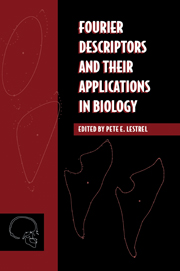Book contents
- Frontmatter
- Contents
- List of contributors
- Preface
- Acknowledgments
- Part one Theoretical considerations
- Part two Applications of Fourier descriptors
- 6 Closed-form Fourier analysis: A procedure for extraction of ecological information about foraminiferal test morphology
- 7 Fourier descriptors and shape differences: Studies on the upper vertebral column of the mouse
- 8 Application of the Fourier method on genetic studies of dentofacial morphology
- 9 Fourier analysis of size and shape changes in the Japanese skull
- 10 Craniofacial variability in the hominoidea
- 11 Heuristic adequacy of Fourier descriptors: Methodologic aspects and applications in Morphological
- 12 Analyzing human gait with Fourier descriptors
- 13 Elliptic Fourier descriptors of cell and nuclear shapes
- 14 Cranial base changes in shunt-treated hydrocephalics: Fourier descriptors
- 15 A numerical and visual approach for measuring the effects of functional appliance therapy: Fourier descriptors
- 16 Size and shape of the rabbit orbit: 3-D Fourier descriptors
- 17 From optical to computational Fourier transforms: The natural history of an investigation of the cancellous structure of bone
- 18 Epilogue: Fourier methods and shape analysis
- Appendix
- Glossary
- Index
13 - Elliptic Fourier descriptors of cell and nuclear shapes
Published online by Cambridge University Press: 14 September 2009
- Frontmatter
- Contents
- List of contributors
- Preface
- Acknowledgments
- Part one Theoretical considerations
- Part two Applications of Fourier descriptors
- 6 Closed-form Fourier analysis: A procedure for extraction of ecological information about foraminiferal test morphology
- 7 Fourier descriptors and shape differences: Studies on the upper vertebral column of the mouse
- 8 Application of the Fourier method on genetic studies of dentofacial morphology
- 9 Fourier analysis of size and shape changes in the Japanese skull
- 10 Craniofacial variability in the hominoidea
- 11 Heuristic adequacy of Fourier descriptors: Methodologic aspects and applications in Morphological
- 12 Analyzing human gait with Fourier descriptors
- 13 Elliptic Fourier descriptors of cell and nuclear shapes
- 14 Cranial base changes in shunt-treated hydrocephalics: Fourier descriptors
- 15 A numerical and visual approach for measuring the effects of functional appliance therapy: Fourier descriptors
- 16 Size and shape of the rabbit orbit: 3-D Fourier descriptors
- 17 From optical to computational Fourier transforms: The natural history of an investigation of the cancellous structure of bone
- 18 Epilogue: Fourier methods and shape analysis
- Appendix
- Glossary
- Index
Summary
Cell shapes
A few general issues concerning the shape of cells, their visualization, spatial considerations, and resolution, need to be examined prior to discussing the use of Fourier analysis. This may somewhat complicate matters, but will allow a better focus on the quantitative evaluation of cell shapes, as well as the suitability and applicability of the proposed methods.
Basic cell shapes
Cell shapes may be divided into four main categories. The first applies to the vast majority of cells, and includes forms with convex or concave surfaces as well as short cytoplasmic extensions of the type found in epithelial, connective tissue, and smooth and cardiac muscle cells (Figures 13.1a–b, 13.1f–k). The second category includes giant structures, known as syncytia, produced by the fusion of several cells. An example of the latter is the long cylinders of skeletal muscle fibers (Figure 13.1c). The third category includes cells with branching processes, which form extended networks. The shape of these latter cells corresponds more to a logic graph (dendrogram or tree structure) than to a simple surface. Nerve cells belong to this group (Figure 13.1d). The fourth category is made up of those forms that differ topologically from the previous ones.
- Type
- Chapter
- Information
- Fourier Descriptors and their Applications in Biology , pp. 307 - 321Publisher: Cambridge University PressPrint publication year: 1997
- 4
- Cited by



